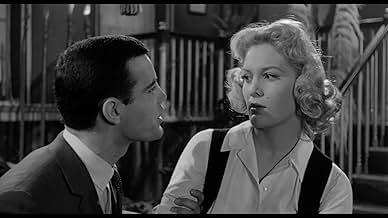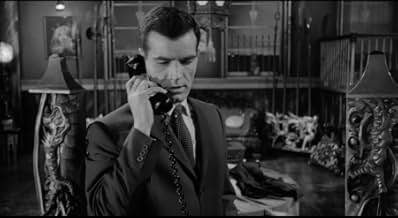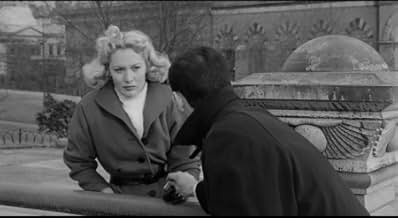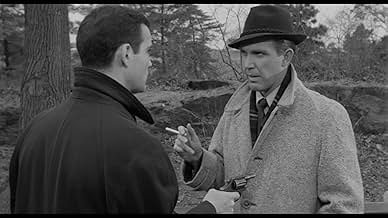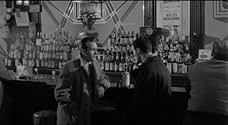CALIFICACIÓN DE IMDb
6.2/10
177
TU CALIFICACIÓN
Agrega una trama en tu idiomaA detective investigating the murder of a heroin addict discovers that there is a connection between the junkie and his fiancee, who is his boss' daughter.A detective investigating the murder of a heroin addict discovers that there is a connection between the junkie and his fiancee, who is his boss' daughter.A detective investigating the murder of a heroin addict discovers that there is a connection between the junkie and his fiancee, who is his boss' daughter.
- Dirección
- Guionistas
- Elenco
- Dirección
- Guionistas
- Todo el elenco y el equipo
- Producción, taquilla y más en IMDbPro
Opiniones destacadas
Another reviewer complained that this wonderful, moody and atmospheric film about heroin addiction was too "dreary.." I have to laugh at some of the comments I read here. New York City, circa 1958; a heroin kingpin sets up shop, and sets himself up in a posh penthouse apartment on Riverside Drive. His customers are mostly kids, many of them Puerto Rican immigrants looking to find their place in a new city, and they get hooked on the smack that Mario supplies them. Things start to get out of control when a Police Lieutenant's daughter gets hooked, while working at a shady nightclub in Midtown. The pusher himself, played by Felice Orlandi, is suitably sleazy and heartless, as he feeds off of the young people in the area, making himself rich while destroying their lives in the process. This film is remarkably realistic in it's depiction of both the business aspect and the addiction aspect of the drug culture. Beautifully filmed in shadowy, stark black and white, with New York City on display in all it's old time glory. Of course it's "dreary," and seedy, and downbeat. This title is very rare and i imagine a copy must be a real collectors item. It reminded me of the New York beat/jazz scene described in Kerouac's "On the Road," so much so, that I half expected William Burroughs to appear in one of those seedy Times Square bars shown in this film. This is a wonderful, lost movie that should be easier to find. Similar to "Hatful of Rain," another early 60's NYC heroin movie, although this one is better. "The Pusher" would make a great double feature with "Who Killed Teddy Bear," which is another 1960's study of the seedy underbelly of New York's times Square scene. A lost gem...
This low-budget, independent picture's most significant point of interest is its writing pedigree -- it's based on a novel by hard-boiled favorite Ed McBain, with a screenplay by the best-selling novelist Harold Robbins. This contributes to a very schizophrenic result. The influence of the former is obvious in the police procedural framework, with some interesting shot-on-location scenes in Spanish Harlem and other NYC locales. The latter's heavy hand is apparent in the overblown melodramatic scenes which especially mar the last couple of reels.
The story concerns a police detective who, while investigating the apparent suicide of a young Puerto Rican heroin addict, discovers that his middle-class daughter is involved in the same underworld. The parallels/contrasts between the white-bread girl and the poverty stricken ethnic types gives this exposé its main social significance -- presaging similar scenes in much more accomplished films like "Traffic". But of course, the good-girl-gone-bad scenario was a staple of old-time exploitation pix way back in the days of silent movies and Dwain Esper.
Unfortunately, the filmmakers, though competent enough for the most part, really have no sense of style or tension, and the film just staggers monotonously from sequence to sequence. It only comes to life during the scenes with a feisty Latin cabaret dancer (the boy's sister), and in the character of the slick pusher who lures the girls into a life of addiction and takes advantage of them in his Playboy-style bachelor pad. Though the subject matter was probably sensational at the time, most modern viewers will find the dramatic scenes clichéd and unsubtle, and the action scenes clumsy. The jazzed-up version of "Billy Boy" that reverberates on the soundtrack is a futile attempt at hipness.
The director was a top-notch Hollywood editor, but this was his only session at the helm of a movie. Watch for some absurdly intense, method-style emoting by the young actors playing gang members.
The story concerns a police detective who, while investigating the apparent suicide of a young Puerto Rican heroin addict, discovers that his middle-class daughter is involved in the same underworld. The parallels/contrasts between the white-bread girl and the poverty stricken ethnic types gives this exposé its main social significance -- presaging similar scenes in much more accomplished films like "Traffic". But of course, the good-girl-gone-bad scenario was a staple of old-time exploitation pix way back in the days of silent movies and Dwain Esper.
Unfortunately, the filmmakers, though competent enough for the most part, really have no sense of style or tension, and the film just staggers monotonously from sequence to sequence. It only comes to life during the scenes with a feisty Latin cabaret dancer (the boy's sister), and in the character of the slick pusher who lures the girls into a life of addiction and takes advantage of them in his Playboy-style bachelor pad. Though the subject matter was probably sensational at the time, most modern viewers will find the dramatic scenes clichéd and unsubtle, and the action scenes clumsy. The jazzed-up version of "Billy Boy" that reverberates on the soundtrack is a futile attempt at hipness.
The director was a top-notch Hollywood editor, but this was his only session at the helm of a movie. Watch for some absurdly intense, method-style emoting by the young actors playing gang members.
United Artists dumped this lousy movie, understandably since it lacks any entertainment value. As the title suggests, there was exploitation movie material to be mined here, but one-shot movie director Gene Milford (whose day job was film editing) delivered a deadly dull stinker with a no-name cast.
Writing credits are strictly A-list: screenplay by Harold Robbins early in his career, from an Ed McBain novel by Evan Hunter. But they have no feel for the genre. It plays like a reject episode of TV's "Naked City" series, with on-location photography plus chintzy studio interiors.
Cops are played by Robert Lansing and John Astin, also having career off-days. Heroine (who is hooked on perhaps heroin?) Kathy Carlyle is good looking but an instant flop -her only other movie was a routine Charles Bronson war picture.
The title character played by Felice Orlandi is a bore -instantly one-note evil. Addiction then and now is a surefire formula for drama, but Robbins, unlike his future amazing success with so many hit novels like "The Carpetbaggers", comes up with nothing but dullness.
Writing credits are strictly A-list: screenplay by Harold Robbins early in his career, from an Ed McBain novel by Evan Hunter. But they have no feel for the genre. It plays like a reject episode of TV's "Naked City" series, with on-location photography plus chintzy studio interiors.
Cops are played by Robert Lansing and John Astin, also having career off-days. Heroine (who is hooked on perhaps heroin?) Kathy Carlyle is good looking but an instant flop -her only other movie was a routine Charles Bronson war picture.
The title character played by Felice Orlandi is a bore -instantly one-note evil. Addiction then and now is a surefire formula for drama, but Robbins, unlike his future amazing success with so many hit novels like "The Carpetbaggers", comes up with nothing but dullness.
God damn the Pusher man. He's got the snazziest digs, wears the sharpest threads, snags the hottest dames, and makes it all look easy. As played by natty hipster Felice Orlandi (Renick in BULLITT), he's like a Bizarro World Hugh Hefner, albeit with a pocketful of smack. This guy is the personification of quiet cool -- that is, until he becomes the object of vengeance by a junkie's unrelenting father, who just happens to be a police lieutenant.
Based on an Ed McBain 87th Precinct novel, THE PUSHER is less a police procedural than a sleazy, heavy-breathing crime meller, which should come as no surprise since Harold Robbins wrote the screenplay.
Personally I wouldn't have it any other way.
Thanks to Robbins' unerring bad taste, the movie is lurid, lowdown fun, chock full of runny noses, twitchy mannerisms, overwrought withdrawals, and all manner of salacious misdoings. Unfortunately, thanks to first-time helmer Gene Milford, it also boasts the dullest, dreariest direction this side of an Edward L. Cahn opus. Hey, life''s full of trade-offs.
On the plus side, the film boasts evocative location photography by ace Big Apple d.p. Arthur Ornitz, a nifty score by renaissance music man Raymond Scott and attention-grabbing performances by Orlandi, Robert Lansing (as 87th Precinct regular Steve Carella) and Sara Amman, a five-alarm Latin hottie who performs a grind-till-you--lose-your-mind specialty dance that's worth the price of admission alone.
Based on an Ed McBain 87th Precinct novel, THE PUSHER is less a police procedural than a sleazy, heavy-breathing crime meller, which should come as no surprise since Harold Robbins wrote the screenplay.
Personally I wouldn't have it any other way.
Thanks to Robbins' unerring bad taste, the movie is lurid, lowdown fun, chock full of runny noses, twitchy mannerisms, overwrought withdrawals, and all manner of salacious misdoings. Unfortunately, thanks to first-time helmer Gene Milford, it also boasts the dullest, dreariest direction this side of an Edward L. Cahn opus. Hey, life''s full of trade-offs.
On the plus side, the film boasts evocative location photography by ace Big Apple d.p. Arthur Ornitz, a nifty score by renaissance music man Raymond Scott and attention-grabbing performances by Orlandi, Robert Lansing (as 87th Precinct regular Steve Carella) and Sara Amman, a five-alarm Latin hottie who performs a grind-till-you--lose-your-mind specialty dance that's worth the price of admission alone.
B-movies are sometimes envisaged as an inferior kind of films. No, it means that the production costs are not as elevated as A-movies. If a star actor gets, say, 1 million dollars for a movie, well, some films (without stars) were made with an overall expenditure of less than 1 million. Now, I don't really care about production's costs, and some B-movies are better than the more high-class ones (not this one, I must say).
The strong positive values of "The Pusher", in my opinion, are the well-defined plot, without any confusing sub-plots or blurred images and shots that let you quite uncertain about what has really happened, and the consequent linear execution of it. This is also a detrimental point, because when you reach minute 16th (of the overall 82), you will know exactly how will the narrative develop.
No thrills, consequently, but if you are a lover of the genre you will enjoy this film. I rated it 6; let's say, more precisely, 6 and a half.
The strong positive values of "The Pusher", in my opinion, are the well-defined plot, without any confusing sub-plots or blurred images and shots that let you quite uncertain about what has really happened, and the consequent linear execution of it. This is also a detrimental point, because when you reach minute 16th (of the overall 82), you will know exactly how will the narrative develop.
No thrills, consequently, but if you are a lover of the genre you will enjoy this film. I rated it 6; let's say, more precisely, 6 and a half.
¿Sabías que…?
- TriviaFilm debut of John Astin.
- ConexionesFeatured in Frightful Movie: The Pusher (1968)
Selecciones populares
Inicia sesión para calificar y agrega a la lista de videos para obtener recomendaciones personalizadas
Detalles
- Fecha de lanzamiento
- País de origen
- Sitio oficial
- Idioma
- También se conoce como
- The Pusher
- Locaciones de filmación
- 113 East 115 Street, Nueva York, Nueva York, Estados Unidos(Location where Anibal Hernandez's Body was found by Police)
- Productora
- Ver más créditos de la compañía en IMDbPro
Taquilla
- Total en EE. UU. y Canadá
- USD 1,656
- Fin de semana de estreno en EE. UU. y Canadá
- USD 1,656
- 9 may 1999
- Total a nivel mundial
- USD 1,656
- Tiempo de ejecución1 hora 21 minutos
- Color
- Mezcla de sonido
- Relación de aspecto
- 1.37 : 1
Contribuir a esta página
Sugiere una edición o agrega el contenido que falta

Principales brechas de datos
By what name was La garra del vicio (1960) officially released in India in English?
Responda
